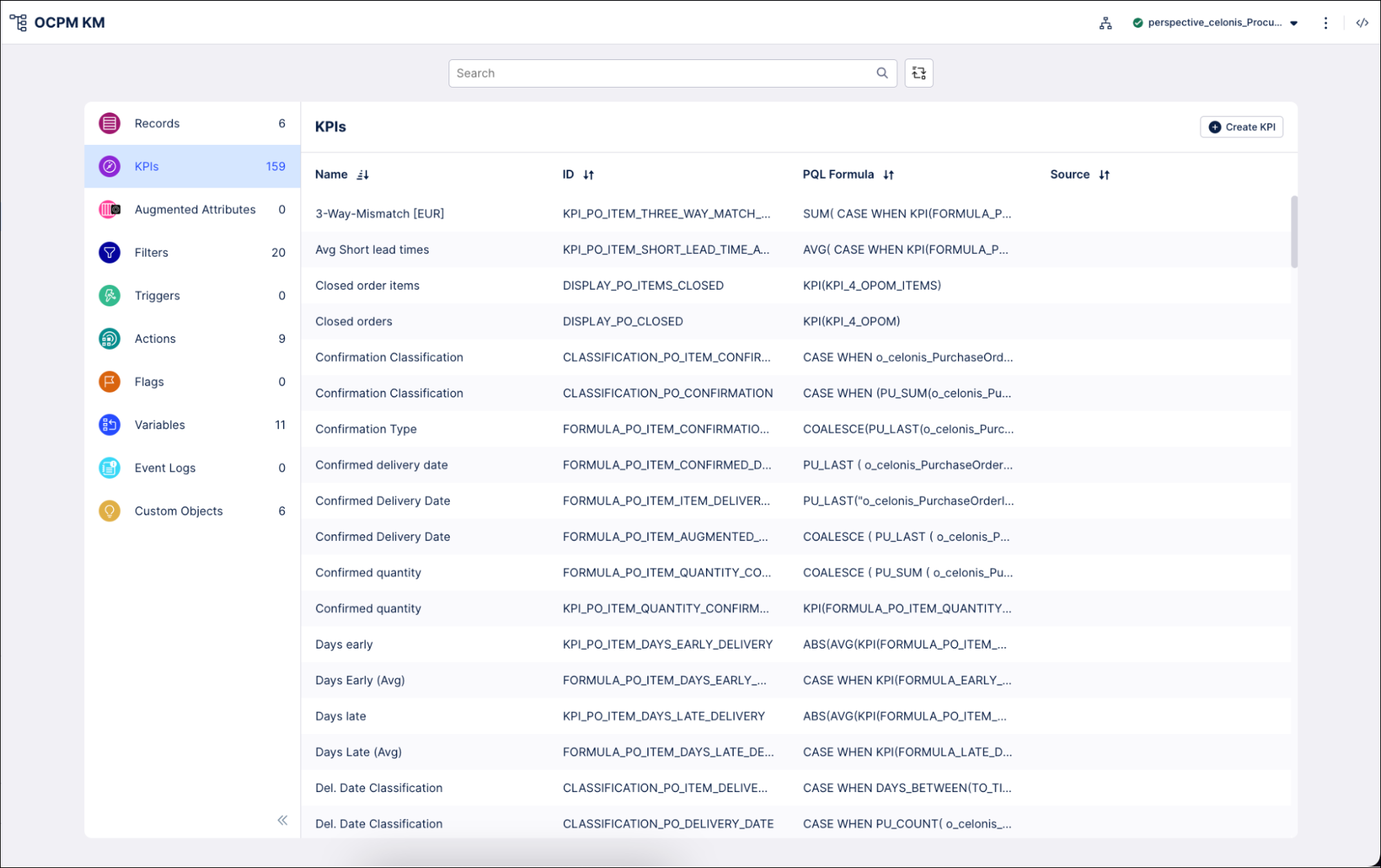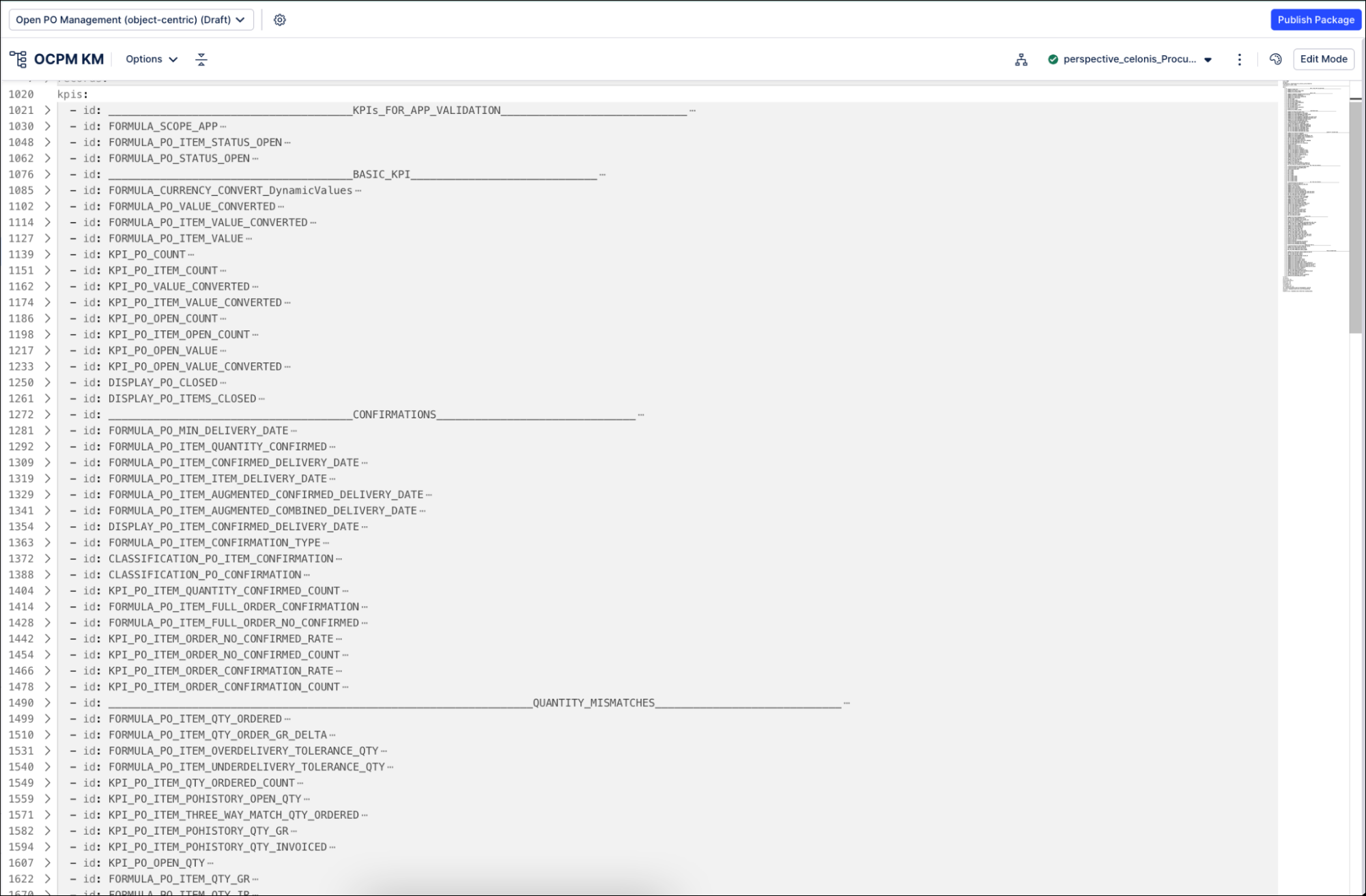Validating KPIs for the object-centric Open Purchase Order Management app
In the Open Purchase Order Management app’s Knowledge Model, check that all the KPIs (key performance indicators) contain the correct business logic for your organization.
The main Knowledge Model for the Open Purchase Order Management app is “OCPM KM”, which is in the app’s Knowledge Models folder. Work with this Knowledge Model to validate and change KPIs. “OCPM KM” points to the base Knowledge Model stored in the Celonis Marketplace, which you can’t update directly. Changes that you make to the PQL formulas, KPI names, or formatting in “OCPM KM” override the base Knowledge Model.
Each KPI in a Knowledge Model contains a PQL (Process Query Language) formula. Some KPIs are reused inside other KPIs as nested formulas. When you adjust the business logic in a single formula, and save it, the change is simultaneously reflected in all the KPIs that reuse the formula.
You work with Knowledge Models in Studio, and any changes you make are applied when you publish a new version of the app. You’ll need Analyst permissions on Studio and the Knowledge Model to modify any of the KPIs and their calculations. If you need training, check out the training track “Build Knowledge Models and Views” on the Celonis Academy.
Here’s how to work with the KPIs in “OCPM KM”:
In the Celonis navigation menu, select Studio.
Find the Open Purchase Order Management app in your Studio space navigation.
Expand the package’s structure using the arrow.
Go to the Knowledge Models folder and select “OCPM KM”.
Select the KPIs section of the Knowledge Model.
You can sort and search the KPIs using their name or ID. The prefix to the ID shows what type of component they are. At the end of these instructions, we’ve noted the most important KPIs to check.
To see and edit the full PQL formula and other settings for a KPI, click its row to open an editor. The editor automatically validates any changes that you make in the PQL formula.
If you want a fuller-featured PQL editor that lets you select from the tables and columns in your data, click on the pen icon next to the PQL formula.
If you need to disable a KPI or formula, click the three vertical dots at the top of the editor, and select Disable Scope, then click Disable to confirm. When you do this, the object can't be accessed or used anywhere in the package, including by other apps that depend on it.
When you’ve made changes to the KPIs, use the Publish Package button at the top of the screen in your Studio space to publish a new version of the app.

To get a better view of how the KPIs fit together, view the Knowledge Model in YAML editor mode. KPIs with the prefix FORMULA_ or CLASSIFICATION_ contain the logic for the use case, and are the ones that you’ll more often need to update. KPIs with the prefix KPI_ aggregate other KPIs to provide a sum, average, rate, count, or other measure of performance.
Warning
If you change the ID of any KPI that is reused as a nested KPI in other KPIs, filters, records, or custom objects, you’ll need to change it in those as well.

For the Open Purchase Order Management app, you can configure the settings for the most important KPIs using the Settings view. Here are some other significant KPIs that need to be managed in the Knowledge Model:
For setting up the scope of the application
FORMULA_SCOPE_APP: Establishes the scope of the app, determining which orders or order items are included on any tabs. The default is all orders. This formula is used in the KPI FILTER_SCOPE_APP.
FORMULA_PO_ITEM_STATUS_OPEN: Defines what is considered an open order item.
FORMULA_PO_STATUS_OPEN: Similar to FORMULA_PO_ITEM_STATUS_OPEN but at the header level.
For the On Time dimension of OTIF
CLASSIFICATION_PO_ITEM_OTD: Classifies the item as late, early, or on time. This KPI is reused elsewhere as a nested KPI.
CLASSIFICATION_PO_ITEM_DELIVERY_DATE: Classifies the item as Overdue, Upcoming, or Delivery in the future. This KPI is reused elsewhere as a nested KPI.
FORMULA_PO_ITEM_OTD: Sets up the logic to consider a delivery as on time. It uses the KPIs FORMULA_LATE_DELIVERY and FORMULA_EARLY_DELIVERY in the logic.
FORMULA_LATE_DELIVERY: Sets up the conditions to consider a delivery late, meaning that it would not be on time.
FORMULA_EARLY_DELIVERY: Sets up the conditions to consider a delivery early, meaning that it would not be on time.
For the In Full (quantity) dimension of OTIF
CLASS_PO_ITEM_QTY_DELIVERED: Classifies the delivery based on its quantity dimension (Partial, Over-delivery, and In-full). This KPI is reused elsewhere as a nested KPI.
FORMULA_PO_ITEM_QTY_ORDER_GR_DELTA: Defines the difference between receipt and ordered, including tolerances.
For OTIF overall
FORMULA_PO_ITEM_OTIF: Integrates the KPIs for the time and quantity dimensions of OTIF.